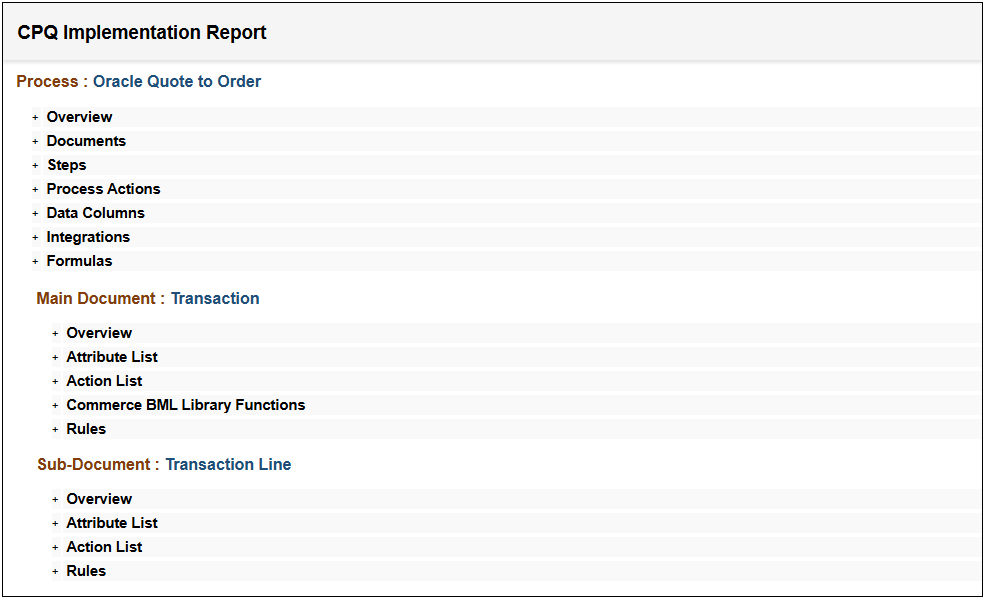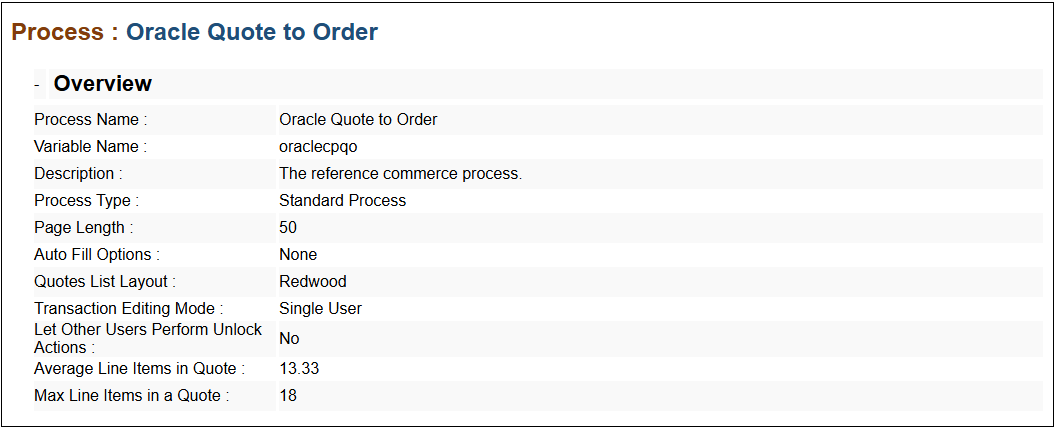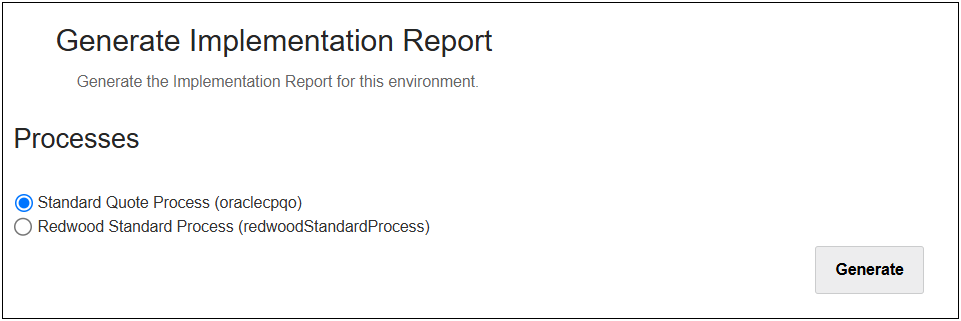Overview
CPQ is a highly flexible platform that allows customers to customize the Commerce process to meet their specific needs. However, this can lead to the creation of artifacts that may later become obsolete or unnecessary. CPQ administrators can run and download an implementation report that provides detailed insights into the customizations made in the Commerce and quoting processes. This enables administrators to rationalize the artifacts, optimize the Commerce process, and remove or refine unnecessary elements.
The implementation report allows customers to efficiently analyze, debug, and optimize the setup, and make informed decisions about deprecating unused attributes.
The Implementation Reports page lists previously generated reports. From this page, administrators can create an implementation report or download previously generated reports.

Oracle CPQ provides a CPQ_Implementation_Report.zip file when you download an implementation report. The zipped file contains the following reports in HTML format:
-
CPQ Implementation Report provides a summary for the Commerce process.
-
Actions Report shows the Id, name, variable name, type, and description for all actions in the Commerce process.
-
Attributes Report shows the Id, name, variable name, type, and description for all attributes in the Commerce process. It also shows if an attribute is required or is referenced in analytics, BML functions, data columns, layouts, or rules.
-
BML Scripts Report displays all Commerce process scripts included in actions, attributes (before formulas, after formulas, and validation), library functions, integrations, rules, and workflow steps.
-
Rules Report shows the name, variable name, type, status, description, condition information, and component information for all rules in the Commerce process.
-
Steps Report shows the Id, name, variable name, order, description, type, and forward type for all workflow steps in the Commerce process.
CPQ Implementation Report
The CPQ Implementation Report contains Process, Main Document, and Sub-Document section.

The Process section contains the following:
-
Overview shows information about the Commerce process (e.g. process type, quote list layout, transaction editing mode). It also displays the average and maximum line items in a quote.

-
Documents shows the name, variable name, and description for the main document and sub-document.
-
Steps shows the order, name, variable name, forward rule, and description for the Commerce process workflow steps. The step links will display the Steps Report.
-
Process Actions shows the name, variable name, action type, and description for the Commerce process actions. The action links will display the Actions Report.
-
Data Columns shows the search label, report label, and variable name for main document and sub-document data columns. It also shows if a data column is indexed or keyword search enabled.
-
Integrations shows the name, variable name, type Id field, description, and timeout for Commerce integrations.
-
Formulas shows the order, attribute name, and formula for Commerce process formulas. It also shows if auto update is enabled.
The Main Document section contains the following:
-
Overview shows information about the main document, including the number of attributes, array set attributes, actions, and rules.

-
Attribute List shows the order, name, variable name, and description for main document attributes. It also shows if an attribute is required or if it triggers an auto update. The attribute links will display the Attributes Report.
Attributes that are used anywhere in the Commerce process will display a Yes link in the Has References column. This allows administrators to quickly identify attributes that are unused in Commerce.
-
Action List shows the name, variable name, action type, and description for the main document actions. The action links will display the Actions Report.
Actions that have before formula, after formula or validation scripts have a Show Function link. The Show Function link displays the BML Scripts Report.
Commerce BML Library Functions shows the name, and description for the BML library functions. The script links will display the BML Scripts Report.
-
Rules shows the name, variable name, description, rule type, and status for the main document rules. The rule links will display the Rules Report.
The Sub-Document section contains the following:
-
Overview shows information about the sub-document, including the number of attributes, array set attributes, actions, and rules.

-
Attribute List shows the order, name, variable name, and description for sub-document attributes. It also shows if an attribute is required or if it triggers an auto update. The attribute links will display the Attributes Report.
Attributes that are used anywhere in the Commerce process will display a Yes link in the Has References column. This allows administrators to quickly identify attributes that are unused in Commerce.
-
Action List shows the name, variable name, action type, and description for the sub-document actions. The action links will display the Actions Report.
Actions that have before formula, after formula or validation scripts have a Show Function link. The Show Function link displays the BML Scripts Report.
-
Rules shows the name, variable name, description, rule type, and status for the sub-document rules. The rule links will display the Rules Report.
Administration
![]() Generate an Implementation Report
Generate an Implementation Report
![]() Download an Implementation Report
Download an Implementation Report







